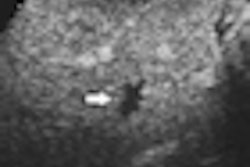Contrast-enhanced ultrasound can identify and localize sentinel lymph nodes prior to breast biopsy, potentially saving early breast cancer patients from having to undergo a second surgery, according to research published in the February issue of the American Journal of Roentgenology.
A study team from Maidstone Hospital in Maidstone, U.K., found that contrast-enhanced ultrasound accurately identified the sentinel lymph node in 89% of the 80 patients included in their prospective study.
Since as many as 35% of patients who undergo sentinel lymph node excision biopsy will require additional surgery because their cancer has spread, the use of preoperative contrast-enhanced ultrasound to produce more accurate biopsies could allow both the cancer and the cancer spread to be removed during one operation, according to the group led by Ali Sever, MD.
At surgical excision biopsy, sentinel lymph nodes are currently identified using blue dye and radioisotopes. But while accurate, this technique also comes with side effects for some patients, including an allergic reaction, according to the researchers.
Between May 2008 and November 2009, the researchers studied 80 consecutive breast cancer patients who were scheduled for primary surgical treatment. All ultrasound examinations were performed using four different scanners with small-parts, high-frequency linear probes and dedicated software packages, according to the researchers (AJR, February 2011, Vol. 196:2, pp. 251-256).
After conventional grayscale ultrasound, an experienced breast radiologist injected SonoVue ultrasound contrast (Bracco, Milan, Italy).
In 71 (89%) of the 80 patients, contrast-enhanced ultrasound images showed visualization of the lymphatic vessels and where guidewires were inserted. Operative findings confirmed that these wired nodes were indeed sentinel lymph nodes.
Contrast-enhanced ultrasound did not identify the draining sentinel lymph node in nine patients; two of these had small (< 20 mm) grade II invasive lobular carcinomas on final histologic examination, according to the authors. One patient had a 34-mm grade II invasive lobular carcinoma, while the remaining six had small (< 20 mm) invasive ductal carcinomas.
A total of 26 sentinel lymph nodes were removed in these nine patients, and all were negative on final histologic examination.
In the next phase of its research, the study team is evaluating if contrast-enhanced ultrasound can be combined with less invasive biopsy techniques to avoid the need for a surgical sentinel lymph node biopsy.
By Erik L. Ridley
AuntMinnie.com staff writer
February 2, 2011
Related Reading
PEM more specific than MRI for presurgical breast cancer planning, November 30, 2010
Axillary reverse mapping limits lymphedema after breast cancer surgery, October 7, 2010
When sentinel node is positive, leave other axillary nodes alone: study, June 8, 2010
Contrast ultrasound makes for less invasive sentinel node staging, November 11, 2009
Copyright © 2011 AuntMinnie.com




















